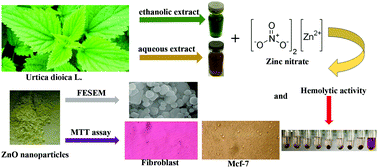当前位置:
X-MOL 学术
›
New J. Chem.
›
论文详情
Our official English website, www.x-mol.net, welcomes your feedback! (Note: you will need to create a separate account there.)
Urtica dioica L. extracts as a green catalyst for the biosynthesis of zinc oxide nanoparticles: characterization and cytotoxic effects on fibroblast and MCF-7 cell lines
New Journal of Chemistry ( IF 3.3 ) Pub Date : 2018-03-07 00:00:00 , DOI: 10.1039/c8nj00496j Maedeh Akbarian 1, 2, 3, 4, 5 , Soleiman Mahjoub 5, 6, 7, 8, 9 , Seyed Mohammad Elahi 1, 2, 3, 4, 5 , Ebrahim Zabihi 5, 6, 7, 8, 9 , Hamed Tashakkorian 5, 6, 7, 8, 9
New Journal of Chemistry ( IF 3.3 ) Pub Date : 2018-03-07 00:00:00 , DOI: 10.1039/c8nj00496j Maedeh Akbarian 1, 2, 3, 4, 5 , Soleiman Mahjoub 5, 6, 7, 8, 9 , Seyed Mohammad Elahi 1, 2, 3, 4, 5 , Ebrahim Zabihi 5, 6, 7, 8, 9 , Hamed Tashakkorian 5, 6, 7, 8, 9
Affiliation

|
Green synthesis using biological agents has been an effective approach for the preparation of various forms of nanoparticles. In this study, according to a green protocol, ethanolic and aqueous extracts of Urtica dioica L. have been utilized for the synthesis of zinc oxide nanoparticles (ZnO NPs). To evaluate the physical characteristics of the ZnO NPs, common techniques such as X-ray Diffraction (XRD), Field Emission Scanning Electron Microscopy (FESEM), Energy Dispersive X-ray Spectroscopy (EDS), Fourier Transform Infrared Spectroscopy (FTIR), Photoluminescence (PL) and UV-visible spectroscopy have been employed. Analysis of the XRD patterns confirmed the hexagonal wurtzite structure and the crystallite size was calculated using the Debye–Scherrer formula to be 19 to 28 nm. Also, the crystallite shape and size of the ZnO NPs were determined using FESEM. The FTIR results confirmed the presence of various functional groups in the NP structure. Some biological assays including in vitro cytotoxicity, hemolytic, and antibacterial activities were performed to evaluate the biological characteristics of the ZnO NPs. The cytotoxic effects of the NPs were determined after exposure to different concentrations (5–200 μg mL−1) at 24, 48 and 72 h. Light microscopic examination was performed and the cell viability was measured using an MTT assay. The results demonstrated that ZnO NPs prepared using ethanolic extracts had lower toxicity than those prepared using aqueous extracts in fibroblast and MCF-7 cell lines. The NPs showed good blood biocompatibility and also reliable antibacterial activities against both Gram-positive and Gram-negative bacteria.
中文翻译:

荨麻提取物作为氧化锌纳米颗粒生物合成的绿色催化剂:对成纤维细胞和MCF-7细胞系的表征和细胞毒性作用
使用生物试剂进行绿色合成已经成为制备各种形式的纳米颗粒的有效方法。在这项研究中,根据绿色协议,荨麻叶的乙醇和水提取物L.已被用于合成氧化锌纳米颗粒(ZnO NPs)。为了评估ZnO NP的物理特性,常用技术包括X射线衍射(XRD),场发射扫描电子显微镜(FESEM),能量色散X射线光谱(EDS),傅立叶变换红外光谱(FTIR),光致发光(PL)和紫外可见光谱已被采用。对XRD图谱的分析证实了六方纤锌矿结构,并且使用Debye-Scherrer公式计算出的微晶尺寸为19至28 nm。另外,使用FESEM确定ZnO NP的微晶形状和尺寸。FTIR结果证实了NP结构中存在各种官能团。一些生物学测定,包括体外进行了细胞毒性,溶血和抗菌活性评估ZnO NPs的生物学特性。在24、48和72小时暴露于不同浓度(5-200μgmL -1)后,确定NP的细胞毒性作用。进行光学显微镜检查,并使用MTT测定法测量细胞活力。结果表明,在成纤维细胞和MCF-7细胞系中,使用乙醇提取物制备的ZnO NPs的毒性低于使用含水提取物制备的ZnO NPs的毒性。NPs具有良好的血液生物相容性,并且对革兰氏阳性和革兰氏阴性细菌均具有可靠的抗菌活性。
更新日期:2018-03-07
中文翻译:

荨麻提取物作为氧化锌纳米颗粒生物合成的绿色催化剂:对成纤维细胞和MCF-7细胞系的表征和细胞毒性作用
使用生物试剂进行绿色合成已经成为制备各种形式的纳米颗粒的有效方法。在这项研究中,根据绿色协议,荨麻叶的乙醇和水提取物L.已被用于合成氧化锌纳米颗粒(ZnO NPs)。为了评估ZnO NP的物理特性,常用技术包括X射线衍射(XRD),场发射扫描电子显微镜(FESEM),能量色散X射线光谱(EDS),傅立叶变换红外光谱(FTIR),光致发光(PL)和紫外可见光谱已被采用。对XRD图谱的分析证实了六方纤锌矿结构,并且使用Debye-Scherrer公式计算出的微晶尺寸为19至28 nm。另外,使用FESEM确定ZnO NP的微晶形状和尺寸。FTIR结果证实了NP结构中存在各种官能团。一些生物学测定,包括体外进行了细胞毒性,溶血和抗菌活性评估ZnO NPs的生物学特性。在24、48和72小时暴露于不同浓度(5-200μgmL -1)后,确定NP的细胞毒性作用。进行光学显微镜检查,并使用MTT测定法测量细胞活力。结果表明,在成纤维细胞和MCF-7细胞系中,使用乙醇提取物制备的ZnO NPs的毒性低于使用含水提取物制备的ZnO NPs的毒性。NPs具有良好的血液生物相容性,并且对革兰氏阳性和革兰氏阴性细菌均具有可靠的抗菌活性。



























 京公网安备 11010802027423号
京公网安备 11010802027423号